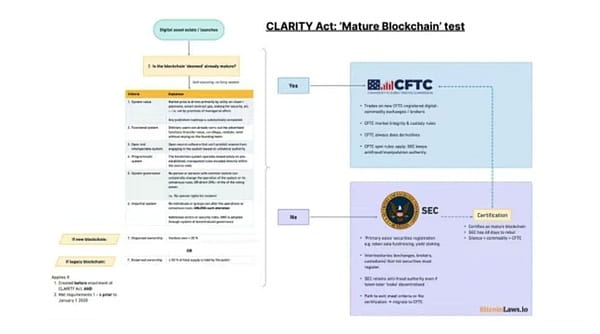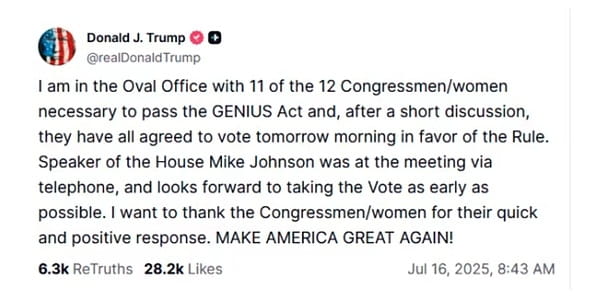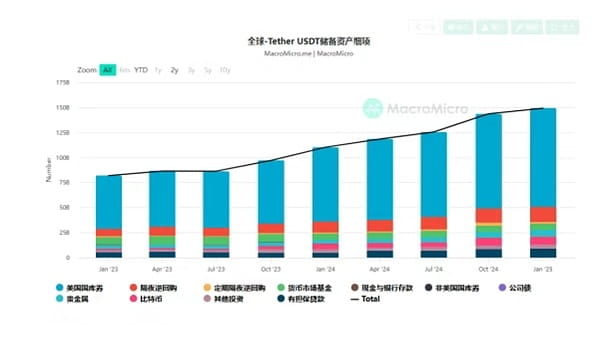Written by: Tuoluo Finance
In the United States, crypto has never been so important.
Just last week, the U.S. Congress ushered in a highly anticipated "Crypto Legislative Week". From avoiding it like a plague to re-establishing its name and even the Congress convening an agenda with crypto as the theme, the crypto world has not been stable in the past decade, but it is definitely fast.
With the crypto bills passing one after another, the highly anticipated stablecoin Genius Act was officially signed by Trump, and the crypto industry undoubtedly ushered in a new journey.
Milestone event! Three major crypto bills passed
Pulling the time back to last Monday, July 14, the U.S. House of Representatives announced in a high-profile manner that the week was "Crypto Legislative Week", attracting market attention. The core of the legislative week is the existing three major bills on crypto, namely the (Clarity for Digital Assets Act) (Clarity Act), the (Anti-CBDC Surveillance State Act), and the (Guidance and Establishment of National Innovation for Stablecoins Act) (Genius Act or Genius Act).
Among these three major bills, the Genius Act and the Clarity Act were proposed this year, and the Anti-CBDC Surveillance State Act has the longest history, first proposed in 2022. Although they are all crypto bills, the core of the three is different. Among them, the Genius Act focuses on the issuance of stablecoins and has the widest awareness. The bill takes payment stablecoins as the core and implements a dual-track management system of interstate and federal. It stipulates that all stablecoins must be pegged to the U.S. dollar high-quality low-risk liquid assets at a 1:1 ratio, specifically including U.S. Treasury bonds, insured bank deposits or physical U.S. dollar cash (including Federal Reserve notes) due within 93 days, and requires stablecoin issuers to disclose stablecoin reserve details every month. The bill was proposed in February and has been signed by Trump as of now. The legislative process ranks first among the three major bills, which shows the importance attached to it by the legislative body and high-level officials.
Compared with the Genius Act, the Clarity Act is much more unfamiliar to people outside the circle. The plan was first submitted by J. French Hill, chairman of the House Financial Services Committee and Republican Congressman from Arkansas, on May 29, 2025, and formed the latest version after multiple rounds of hearings and deliberations. As the name suggests, the word "clarity" reflects the most important concern of the bill - regulatory power issues. Due to the difficulty in defining the nature of cryptocurrencies, the dispute between the securities theory and the commodity theory has never stopped since the beginning of cryptocurrencies. In addition, the SEC and the CFTC have very intense competition for their jurisdiction due to the relatively richer capital confiscated in the crypto industry compared to other industries. Before Trump came to power, the SEC was the famous "crypto police officer", dispatching various projects from time to time, and frequent Wells notices once made the industry tremble. USDT, USDC, ETH, and SOL were all included.
The Clarity Act is to solve this problem. The bill establishes clear classification standards for digital assets, dividing them into digital commodities, investment contract assets, and non-commodity collectibles, clarifying the property disputes of cryptocurrencies, and constructing a regulatory pattern with two institutions dividing their work, that is, the spot market for digital commodities is the responsibility of the CFTC, and the issuance of securities and anti-fraud enforcement are the responsibility of the SEC.

The "(Anti-CBDC Surveillance State Act)" directly states its content in the name. The key content is to prohibit the Federal Reserve from issuing a retail central bank digital currency (CBDC) without explicit authorization from Congress. As we all know, during Biden's administration, he maintained a relatively open attitude towards CBDCs and digital dollars, and even signed an executive order in 2022 instructing government agencies to study the creation of a CBDC. However, in American politics, it is common to change policies frequently. In January 2025, Trump signed an executive order suspending all retail CBDC research and development, citing its potential use as a government surveillance tool. After that, the "(Anti-CBDC Surveillance State Act)", which was proposed in 22 years, was quickly put on the legislative agenda and was passed by the House Financial Services Committee on April 3 this year, becoming an issue of Crypto Legislative Week.
From the latest approval situation, both the Clarity Act and the Anti-CBDC Surveillance State Act have been passed by the House of Representatives and are heading to the Senate agenda. The Genius Act, which is the fastest, has become a formal law after being signed by Trump and will take effect 18 months after Trump's signature, or 120 days after the "major federal payment stablecoin regulatory agency" (including the Treasury Department and the Federal Reserve) issues the final regulations implementing the bill. This is the first cryptocurrency law in the United States and is undoubtedly a major breakthrough in crypto legislation. If you carefully observe the content of the bill, it is no coincidence that the three major bills can be included in the crypto week. The three are actually complementary to each other. Stablecoins, as the industry's ballast stone, continue to expand the U.S. dollar boundary and attract institutions to enter the market. Clarity clarifies regulatory clarity and further promotes the expansion of the industry scale. The anti-CBDC bill directly stifles the biggest opponent of cryptocurrency, the digital dollar, in the cradle, stabilizes the crypto base, and establishes the ideology. It can be considered that the three work together to maximize crypto value, and to the greatest extent, through the integration of crypto and traditional finance, realize the reconstruction of U.S. dollar value in the digital currency field.
Not smooth sailing, the interest game behind the three major bills
But where there are vested interests, there will naturally be games. The seemingly very smooth approval process was not smooth sailing. The interest game behind the legislation can be called wonderful. On the eve of the Genius Act's approval, Trump told party supporters that all members should immediately release and agree to it. According to this year's election of 220:212 seat difference between the two parties, plus the background of some Democratic supporters, the passage of the bill should be a certainty. As a result, on July 15, the House of Representatives rejected the Genius Act with a vote of 196-223. The key was that his own people reneged, and 12 House Republican members performed a reversal on the spot.
The reason is that at that time, the two parties were arguing endlessly about whether the Genius Act should be included in the (Anti-CBDC Surveillance State Act). The Republican Party believed that if the anti-CBDC clause was not added, it might leave hidden dangers for the subsequent issuance of the U.S. CBDC. One link after another, around the (Clarity Act) and the (Anti-CBDC Surveillance State Act) integrated package, new problems arose. The bundling faction represented by Coinbase, the largest cryptocurrency exchange in the United States, and other industry giants believes that all cryptocurrency legislation should be completed in one step, while the pragmatic faction centered on Defi advocates taking small steps quickly, first passing the (Genius Act) and then talking about others. The demands are also understandable. Industry giants have already accumulated a lot in the direction of compliance and have a first-mover advantage. If cryptocurrency legislation is completed, they can obtain the most market dividends. At the same time, the giants are difficult to adjust and prefer more certain one-stop legislation. Defi has always been wandering in the gray area of regulation. For the community, any legislation has a promoting effect, and it is obviously better the faster the efficiency.

After the reversal performance, Trump was slapped in the face, obviously feeling resentful. That evening, Trump immediately took thunderous measures and led the 12 members who voted against to the office for talks. The content of the talks is unknown. But from the results of the second vote on July 18, the arms ultimately could not twist the thighs. After nearly ten hours of tug-of-war, the longest legislative vote in history finally passed smoothly. The U.S. House of Representatives passed the (Genius Act) with 308 votes in favor and 122 votes against.
Overall, although the three major legislations have twists and turns in the process, they will be passed sooner or later with the strong support of the president. If we add the fact that more than one-fifth of Trump's cabinet holds cryptocurrencies, the time to pass is expected to be greatly shortened. According to industry analysis, the Clarity Act is relatively more difficult to pass because it involves the transfer of ownership and has a greater impact on the market, and the Democratic Party's resistance to it is also greater, while the "(Anti-CBDC Act)" is likely to formally take effect before the end of this year.
What impact do the three major bills have on the market?
The impact of the three major bills on the market is visible to the naked eye, and both the coin and stock sides are cheering for this event. Bitcoin has repeatedly broken new highs, breaking 120,000 three times, reaching a maximum of 123,000 U.S. dollars, and now it has fallen back to 119,000 U.S. dollars. The ETH sector rotation has also officially started, ETH soared to 3,790 U.S. dollars, SOL came to 189 U.S. dollars, and BNB once again broke 760 U.S. dollars. Among the top 100 cryptocurrency species in market value, 52 have shown gains. Under the benefit of the stablecoin bill, Circle, the first stablecoin stock, rose by more than 1.45%, and the related Coinbase also rose to the 400 U.S. dollar range, and is now reported at 419.78 U.S. dollars.
In addition to prices, industry changes are also quietly arriving. First, the (Clarity Act) lists seven objective and measurable standards to determine the attributes of digital assets, greatly reducing the risk of securities, especially for DeFi projects that have suffered from securities, and can exempt the DeFi system from federal intermediary rules. Although the secondary regulatory model has the suspicion of pushing up regulatory costs, it provides regulatory protection for the industry. Against this background, it can be predicted that the CTFC will gradually acquire law enforcement sovereignty from the original marginal enforcement and transition to becoming a more important regulatory agency for cryptocurrencies. Among them, large centralized exchanges will benefit the most, and can reasonably open up new institutional tracks, while DeFi and other application projects either join the system to obtain deterministic dividends, or can only face marginalization.
At the same time, stablecoins will be the most affected area. As mentioned earlier, the epoch-making impact of the Genius Act is to open up a new rule for private coin issuance, and the Anti-CBDC Act further strengthens this point. From then on, the era of private seigniorage will begin. Traditional companies, financial institutions, and even qualified technology companies can enter this track. Taking Bank of America and JPMorgan Chase as examples, both have actively stated that they will participate in stablecoin construction, and the track will soon become crowded. However, according to Rhythm's forecast, new entrants will face initial setup costs of $1-3 million and ongoing compliance costs of $2-10 million per year, which shows that only strong companies can stand out.
For the existing stablecoin track, the industry pattern is expected to be reshaped. First, the leading companies will face the dual challenges of compliance and competition. The offshore issuer Tether not only faces the compliance issues of collateral (about 85% of which is supported by cash and cash equivalents, not 100%), but also needs to directly face the impact from a wide range of competitors. Decentralized stablecoins are even more tricky. Whether it is the reserve ratio or the governance structure, they will face regulatory tests. If they cannot comply within the two-year transition period, they will be explicitly prohibited from issuing.

In addition, there is a lot of discussion about whether stablecoins should pay interest under existing regulations. In order to curb the impact of stablecoins on the existing system, the Genius Act clearly stipulates that payment stablecoins cannot pay interest to holders, and users need to find other DeFi protocols to obtain income. However, there is also room for operation, such as transferring to yield-bearing stablecoins, or using payment stablecoins to purchase U.S. Treasury bond tokens, circumventing the realization of this interest-bearing attribute.
Regardless of whether it is interest-bearing or how fierce the competition is, the biggest winner will inevitably be the U.S. dollar system. Through layers of legislative nesting, the long-arm mechanism of the U.S. dollar with stablecoins as a grip has been further strengthened. Under the influence of the core asset anchoring of stablecoins, the core of stablecoins is actually U.S. dollar assets, and stablecoins objectively serve as the value scale and circulation means of the crypto market. Against this background, the United States will collect crypto to the regulatory side, which not only does not cost a single soldier to harvest the existing crypto results, but also successfully promotes the reconstruction of the U.S. dollar hegemony in the crypto field, and promotes the U.S. dollar to continue to extend its influence in the digital age with the expansion of crypto scale, and further forms a situation of confronting the global CBDC. On the other hand, under the mandatory binding of legislation, the development of stablecoins will promote the market demand for U.S. Treasury bonds, alleviate the existing debt crisis in the United States, and form a capital repatriation mechanism.
The finalization of the legislation declares the official arrival of the institutional era. Crypto finally becomes an adjunct of the U.S. dollar, the market is filled with mixed emotions, but it ultimately ends with a rise. Perhaps for everyone, what is worth celebrating is that crypto has boarded the table, and the position is always more important than the ability.


